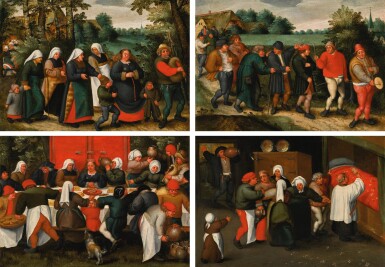
Property from a Private Collection | 私人收藏
MARTEN VAN CLEVE THE ELDER | The Procession of the Bride; The Procession of the Groom; The Wedding Feast; The Blessing of the Marriage Bed | 老馬騰・凡・克萊費 | 《新娘隊伍》;《新郎隊伍》;《婚宴》;《婚床祝福》
Auction Closed
December 4, 08:03 PM GMT
Estimate
220,000 - 280,000 GBP
Lot Details
Description
Property from a Private Collection
私人收藏
MARTEN VAN CLEVE THE ELDER
老馬騰・凡・克萊費
Antwerp circa 1527 - before 24 November 1581
約1527年生於安特衛普,1581年11月24日前卒
The Procession of the Bride; The Procession of the Groom; The Wedding Feast; The Blessing of the Marriage Bed
《新娘隊伍》;《新郎隊伍》;《婚宴》;《婚床祝福》
a set of four, all oil on panel
一組四幅,油彩畫板
each: 26 x 37.3 cm.; 10¼ x 14½ in.
各幅:26 x 37.3公分;10 ¼ x 14 ½英寸
(4)
Private collection, since the early 20th century;
Anonymous sale (‘The Property of a Lady’), London, Christie’s, 6 July 2010, lot 12;
There acquired by the present owner.
K. Ertz, Marten van Cleve 1527–1581, Lingen 2014, p. 200, nos 143–46, reproduced (with incorrect provenance).
Marten van Cleve became a Master in the Antwerp Guild of Saint Luke between 1551 and 1552, at the same time as Pieter Bruegel the Elder. He probably set up his own independent workshop around 1555/6, where he specialized particularly in low-life scenes such as kermesses and peasant weddings and dances as in the present pictures. Although his paintings in this vein were much indebted to the example of his more famous contemporary, Van Cleve’s surviving work show him to have been an original and independent painter in his own right. Like Bruegel the Elder his works were themselves copied and proliferated by the next generation of painters in Antwerp, most notably the former’s son Pieter Brueghel the Younger. These panels are typical of Van Cleve’s work and depict a series of episodes from a peasant or country wedding. In the first panel we see the procession of the smiling and demure young bride and her family to the church, while in the second the bridegroom, similarly escorted by friends and family, gestures anxiously towards the church, whither he has to be pushed on his way by an older kinsman. The third panel depicts the wedding feast itself, with the young bride, crowned as queen of the day, surrounded by feasting revelers. Her cheerful demeanour, however, has visibly altered in the last panel to one of panic, as she is being dragged towards the marriage bed by her family even as it is being blessed by the local priest. The appearance of her new husband at the door, visibly drunk and staggering with a large beer jug, suggests that her misgivings are not entirely ill-founded.
This one of three such sets of wedding paintings by Van Cleve and his shop that have come down to us, and seemingly much the best in quality. The largest of these groups is a set of six panels formerly in the collection of Johann Arnold Freiherr von Schütz-Leerodt, and today in a private collection in Antwerp.1 This set includes the additional scenes of the bride receiving her wedding gifts, a variation of the blessing of the marital bed, and an implausibly connected panel depicting a lover’s departure. A second set, since broken up, in which the wedding gifts are added and the blessing of the marital bed and the departing lover are omitted, was sold London, Sotheby’s, 9 April 1986, lot 30.2 A fourth set of five panels (present whereabouts unknown) also includes this last scene, as well omitting the procession of the groom to the church and replacing it with a wedding dance.3 The general level of quality here, however, does not rise above that of workshop production, and the group altogether lacks the same sense of humour shown in the others. The survival of numerous replicas or variants of some of the scenes (notably the wedding celebrations) suggests that there may have originally been many more such sets, or that their popularity was such that they were produced as individual subjects in their own right. At least two of the scenes, the Procession of the bride and the Procession of the groom, were copied by Pieter Brueghel the Younger (1564–1637/8) and his workshop. Good examples, formerly at the Nelson Atkins Museum of Fine Art, Kansas City, are now in a private collection.4 Though smaller in number than these other groups, there is no reason to suggest that these panels were once part of a larger group. Their notably high quality may well stem from their much smaller scale than the others, and the greater concentration on details and more intimate mood that it allows.
1 All oil on panel, each 33.7 x 68.6 cm. See Ertz 2014, vol. II, p. 199, nos 137–42, reproduced.
2 All oil on panel, 43 x 76 cm. G. Marlier, Pierre Brueghel le Jeune, Brussels 1969, pp. 342–43, figs 207–10; Ertz 2014, vol. II, p. 201, nos 147–51, all reproduced.
3 Sold London, Christie’s, 8 July 2005, lot 23 (as a follower of Marten van Cleve).
4 K. Ertz, Pieter Brueghel der Jüngere, Lingen 2000, vol. II, p. 699, nos 807 and 808, reproduced figs 499 and 500.
